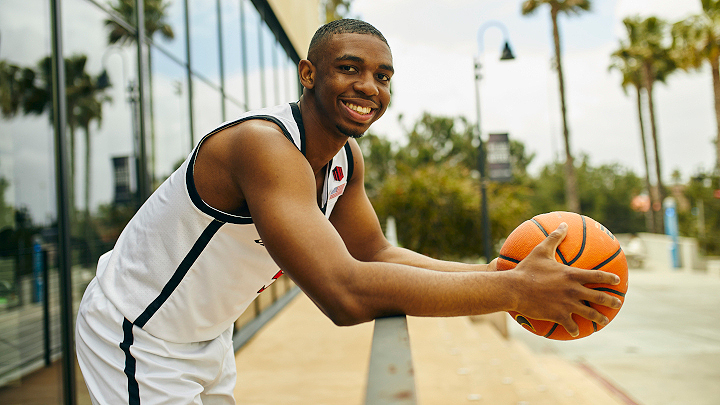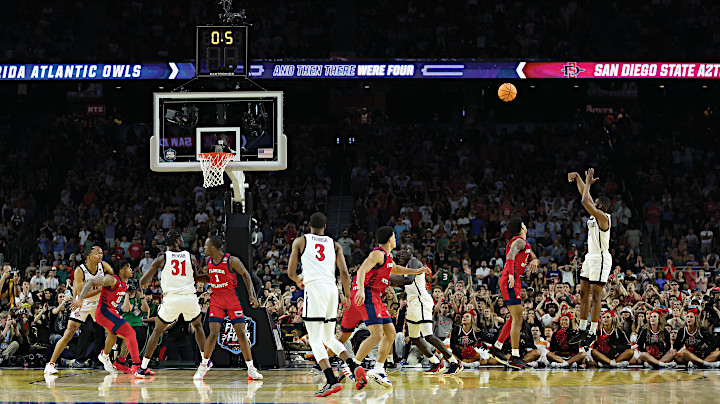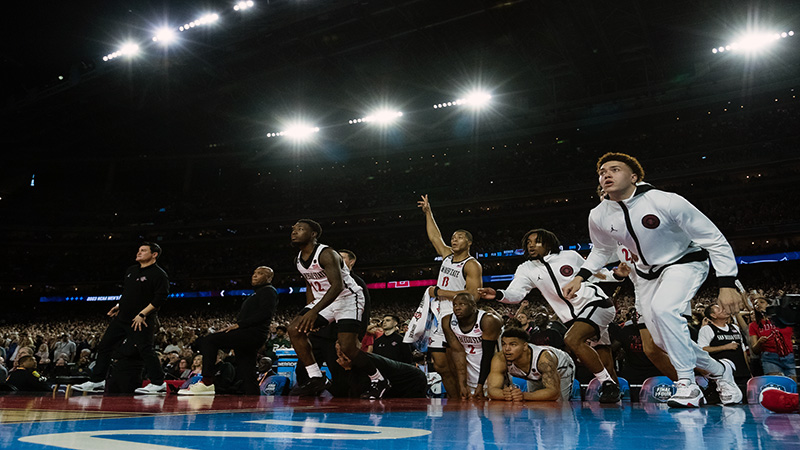Calm Under Pressure
Lamont Butler didn’t emerge as the star of the March Madness tournament by accident. He spent countless hours honing his game. What will his game-winning shot and the team’s monumental run mean for San Diego State University?
By Wayne Drehs
This story was published in the Summer 2023 Issue of SDSU Magazine.

SEVEN SECONDS. That’s how long Lamont Butler had to save San Diego State University’s chance at playing in the 2023 NCAA men’s basketball championship in Houston. The Aztecs had cut Florida Atlantic University’s 14-point lead to one. Now it was on Butler to get to the basket and either draw a foul, dish to an open teammate or shoot. After eight dribbles, Butler found himself in the corner, planting his right foot within an inch of the baseline. He looked up at the clock.
Two seconds. Butler dribbled once more to create space. And then, 18 feet from the basket, he left the ground for the biggest jump shot of his life.
“I felt really good about it,” the rising senior says.
It took 1.7 seconds for the ball to travel from the fingertips of Butler’s right hand through the bottom of the net. While the ball sailed through the air, the game clock fell to 0.0, red lights illuminating the backboard. The final buzzer sounded — and the future of a young man and the university he proudly represented were forever changed.
Instantly, Butler’s world transformed into a blur of high-fives, media interviews, phone calls and incessant text messages. It wasn’t until more than an hour later, back in the hotel room shower, that he found a moment to himself. The bathroom mirror began to fog. Hip-hop duo BlueBucksClan played through Butler’s phone. And Butler tried to process the insanity his shot helped create.
“It’s not like I was totally surprised, but at the same time, you’re shocked by the moment,” Butler says. “You have people saying it’s one of the greatest shots in March Madness history, in college basketball history. And now we’re playing for the national championship. It was crazy.
“I just kept thinking, This is no ordinary shot. No ordinary moment in life.”

THE FULL IMPACT of that April 1 buzzer-beater and the Aztecs’ historic tournament run won’t fully be understood for years. JD Wicker, SDSU’s director of intercollegiate athletics, says the school has already begun the process of trying to quantify what effect the monthlong presence all over television, in news reports, on social media — and more — could have on the university.
SDSU’s early research indicates that during a four-week period — spanning the weeks before and after the title game — an estimated $402 million was generated in publicity from TV, print and radio. As an external example, after George Mason University reached the Final Four in 2006, a researcher at the school’s Center for Sports Management estimated the media exposure was worth $677 million. For first-time Final Four schools, the increased exposure can lead to a boost in student applications, enrollment numbers, alumni donations and broader visibility of university programs and initiatives. The first-year applications at George Mason increased 22% the fall after the school’s Final Four run. A 2015 Forbes study found that from 2009 to 2015, a year after making the Final Four, schools saw an average of an 11% increase in applications.
“It’s 14 million people being introduced to our university,” Wicker says, referring to the global TV audience for the championship game. “We’ve been working hard to build the brand of the athletic department and the institution. This is the best opportunity we’ve had.”
Even before the tournament, SDSU had received more than 100,000 student applications for 2023–24. The university uses a complicated formula to determine how many students it accepts, typically sending offers to roughly 30,000 students each year. The goal is to secure a first-year class of around 6,000.
Also anticipated is a financial boost. The year after Villanova University won the 2016 NCAA championship, the school saw a 56% jump in alumni donations over the previous year. There are also potential increases in merchandise sales, sponsorship and advertising revenue, and ticket sales.
But perhaps the biggest boon could be to SDSU’s résumé in the constantly shifting world of conference realignment. According to Wicker, the university has discussed joining a conference like the PAC-12 or Big 12. With this year’s Final Four run, the Aztecs have the best combined football and men’s basketball winning percentage in the country. That on-field success — combined with SDSU’s growing research enterprise, pursuit of R1 research status, the success of its students and reduction in achievement gaps, and both the emergence of SDSU Mission Valley and the expansion of SDSU Imperial Valley — leads the Aztecs to believe they will be a highly sought-after candidate in a potential realignment.
“Having success in football and men’s basketball is crucial to go with all the other pieces [that SDSU has to offer],” Wicker says. “To make it to the national championship game shows you can win at the highest level in one of the higher-priority sports. It’s hugely beneficial.”
TWELVE DAYS AFTER the greatest moment of his basketball life, Lamont Butler stepped on the pitching rubber at Petco Park in San Diego, his teammates lined behind him. He and Aztecs head coach Brian Dutcher waited for the cue to throw simultaneous first pitches at the Padres game.
When the SDSU players and staff arrived that evening, the Padres welcomed them with authentic custom jerseys and a luxury suite to watch the game. It was the latest in a string of celebrations where San Diego wrapped its arms around the Aztecs, a team that was one game from giving the city its first major sports championship.
Earlier that day, Butler admitted he had barely thrown a baseball in his life. Before the big moment, he practiced with the Padres game operation staff in right field. It wasn’t pretty. A few throws bounced in front of the catcher. Others shot over the staff member’s head. Yet others were perfectly on target. “You ready for this?” Dutcher asked with a skeptical tone. “You can’t bounce it.”
On the giant video board in left field, highlights replayed from the Aztecs’ tournament run, including Butler’s dramatic jump shot. Players like forward Aguek Arop and guard Micah Parrish smiled, phones out capturing the scene. Forty thousand fans stood and cheered. And Butler waved.
His Final Four buzzer-beater had cemented his place in college basketball history. His Instagram followers doubled. Students around campus now nervously asked for selfies with Butler and his teammates or whispered when they walked by. NBA players, including Onyeka Okongwu of the Atlanta Hawks and Trey Murphy III of the New Orleans Pelicans, reached out to Butler. His game-winner had helped place SDSU in its rightful seat at the sport’s head table.
What unfolded was the vision Dutcher and former head coach Steve Fisher had when they arrived from Michigan in 1999. Before then, SDSU basketball coaches didn’t even have their own offices. They worked out of a trailer across the street from Peterson Gym, the 3,000-seat multipurpose arena the Aztecs then called home. In 1997 the school opened the 12,000-seat Cox Arena, now Viejas Arena. And in 1999, the Aztecs became charter members of the Mountain West. Two years after that, the school opened the now Fowler Athletics Center, complete with brand-new administrative offices.
Patience, however, was paramount. March basketball is geared for chaos. Three hundred and fifty-eight teams vie for 68 spots in a single-elimination tournament. Two reach the season’s final game. For the Aztecs, their deepest tournament runs had ended in the Sweet Sixteen: once in 2011 with Kawhi Leonard, now with the Los Angeles Clippers, and again in 2014. The 30–2 team from 2020 was ranked No. 6 in the nation and eyeing a No. 1 seed in the tournament until the season was canceled due to the COVID-19 pandemic. In their last three NCAA tournaments, the Aztecs didn’t advance past the first round.“It was like a Field of Dreams. The rise of the athletic department coincided with the rise of the entire university. We knew we could make this happen.”
This time was different. The march to the final was not a clichéd tale of an unheralded Cinderella, but rather a testament to the hard work, determination and unwavering resolve Dutcher and Fisher spent two decades building into the Aztec basketball culture. Like most SDSU teams, it was a group of hard-working, unselfish, defensive-minded grinders whose belief in what they could accomplish never wavered.

A FEW MINUTES after the shaky practice for his first pitch, Butler wound up and delivered a perfect strike to the Padres catcher. A few feet away, Dutcher did the same and chuckled. “That’s Lamont,” the coach said later.
The guard’s path to college basketball history had mirrored his university’s: challenging. In the midst of an up-and-down 2021–22 season, Butler learned that his 30-year-old sister, Asasha Lache Hall, had been killed in late January. Butler pondered quitting basketball. She was his biggest fan and attended every home game with their parents, Lamont Sr. and Carmicha Butler, wiggling her way down to sit as close to the court as possible. He couldn’t imagine a game without her there.
“It was hard,” says Butler, the youngest child with two other sisters. “I was kind of lost. I was confused. I didn’t know if my family needed me to be there for them. Basketball is something I love. And she loved watching me do that. I realized that when I was playing it took my mind off things. It freed me from the grief and the pain. So I tried to throw myself into the game.”
Butler said his teammates and coaches gave him the support and the space he needed to figure out a path forward.
“You can’t preach family. You have to be family,” Dutcher says. “Our coaches, his teammates, we all tried to be there for him. For whatever he needed on a given day.”
Last summer, frustrated by an inconsistent season and pushed by his coaches to improve his midrange game, Butler lived at the Jeff Jacobs JAM Center, the men’s and women’s basketball practice facility, working tirelessly on improving his consistency. He tried to rediscover the stroke that helped him break basketball legend Reggie Miller’s scoring record at Riverside Polytechnic High School just 100 miles north of San Diego. Along the way, he found Miller’s late-game magic, hitting a buzzer-beater to beat the University of New Mexico in a critical late-season Mountain West game. He also discovered the confidence and resiliency needed to press on without his sister.
“That’s the hardest thing I’ve been through in my life,” Butler says. “You go through something like that, you work through it and you learn there aren’t many things that can hold me down.”
It is these sorts of intangibles that the Aztec No. 5 believes might help him make it to the NBA. Three days after his first pitch at the Padres game, Butler packed his car and headed for Las Vegas to work with a trainer in hopes of improving his NBA draft stock. He had declared for the June 22 annual event, along with rising fifth-year seniors Keshad Johnson and Jaedon LaDee.
Prior to the NCAA tournament, Butler was a blip on scouts’ radars. But his steady play, leadership and poise in the game’s biggest moments opened a door he felt obligated to explore. After training for two months in Las Vegas, Butler processed everything he learned through his evaluations and on May 29 announced his return to SDSU for his senior season. “Forever an Aztec,” he posted on social media alongside a black heart and a red heart. As for Butler’s teammates, LaDee will also remain an Aztec, and Johnson signed with the University of Arizona.“We’ve always had good players and good people. But people doubted us and overlooked us because we weren’t able to make that sort of run. But now the university will have that respect, so will our culture and people who play here. It’s historic.”
A FEW HOURS before the first pitch at the Padres game, Butler pulled his home Aztecs jersey over his head for the first time since his 18-foot shot made history. This time he wore it for a photo shoot at the JAM Center. The black-and-blue, space-themed Final Four logo was still attached to the jersey’s lapel. Butler dragged his fingers across the patch, looking down at it. “Crazy,” he says with a grin.
While the Aztecs’ postseason run may have opened an NBA door for Butler, Aztec fans wonder if it will bring more high-profile basketball recruits to San Diego. They got an indication of such when University of Southern California transfer ReeseDixon-Waters, the Pac 12’s Sixth Man of the Year and a 4-star recruit out of high school, selected SDSU as his new home.
But Dutcher insists his recruiting priorities will largely remain the same and points to the most recent lineup as a reason why. His starting five in the national championship featured 4-star recruit Matt Bradley, 3-star recruits Butler, Johnson and Nathan Mensah, and unranked guard Darrion Trammell.
“We just had a group of players who took us to the national championship game,” Dutcher says. “Will this give us more national recognition? Of course. Will it change the way we recruit? Probably not. We want guys who have a feel for the game, who have a bit of a chip on their shoulder and aren’t reading all their press clippings thinking they’ve already arrived. Guys who are hungry. And are about the right things.”
Guys like Lamont Butler.
The morning after the Aztecs returned to San Diego from the Final Four, Dutcher was back in the office recruiting. The trophies from the Mountain West tournament and NCAA regional championship sat on the floor of the basketball office lobby, draped in the nets the players and staff cut down after the clinching victories. Dutcher’s mind was already on what’s next. He began working the phones in a quest to build the next great SDSU team.
“The goal is to put a team together better than this one and see what happens,” Dutcher says. “That’s the beauty of the NCAA tournament. You could start this year’s tournament over with the exact same bracket and there would probably be four different teams in the Final Four. That’s how hard it is to win a game.”
Because it all can come down to one 20-year-old college athlete. With two seconds left on the clock. Standing 18 feet from the basket.
“Looking back on it,” Butler says, “you can’t help but ask if God has a plan for all of us when we have to go through certain things so we can handle other moments. I still sit around at times and think to myself, Dang. That really happened. It’s just crazy.”
